Do you have a captivating story or valuable knowledge that you’d like to share with the world? Writing an ebook is one of the best ways to bring your ideas and expertise to life. With artificial intelligence (AI), crafting an engaging ebook has never been easier. This extensive guide will walk you through every step of writing, formatting, and distributing your ebook – all while using the power of AI to make your journey smoother than ever before. And I’ll share my experience along the way.
What is an Ebook?
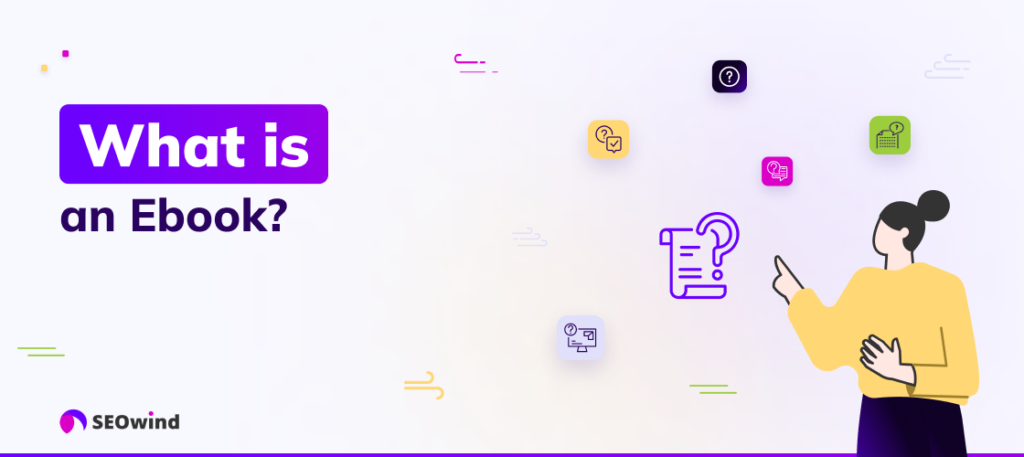
An ebook, short for electronic book, is a digital publication containing text, images, or both, which can be read on various devices such as computers, tablets, e-readers, and smartphones. Ebooks use specific file formats for easy screen readability and offer features like searchable text and adjustable font sizes. In essence, they are the modern evolution of traditional printed books.
Some common types of ebooks include novels, how-to guides, memoirs, educational materials, or even poetry collections. They can be distributed through popular platforms like Amazon Kindle Direct Publishing (KDP), Barnes & Noble Nook Press, Apple Books Author Tool Suite, or independently using websites or dedicated landing pages.
There are several benefits associated with writing and reading ebooks:
- Ease of access: Readers can access their favorite books anytime and anywhere- all they need is a compatible device.
- Reduced costs: Compared to printing physical copies, producing digital versions reduces authors’ manufacturing expenses and offers readers lower prices.
- Environmentally friendly: Ebooks leave a smaller carbon footprint by eliminating paper waste created by traditional publishing methods.
- Customization options: Digital publications allow readers to tailor their experience according to their preferences – from adjusting font size to altering background colors.
As eBooks continue growing in popularity among consumers and writers alike due to these benefits, learning the ropes of crafting enthralling ebooks that captivate your target audience is essential.
Benefits of Writing an Ebook
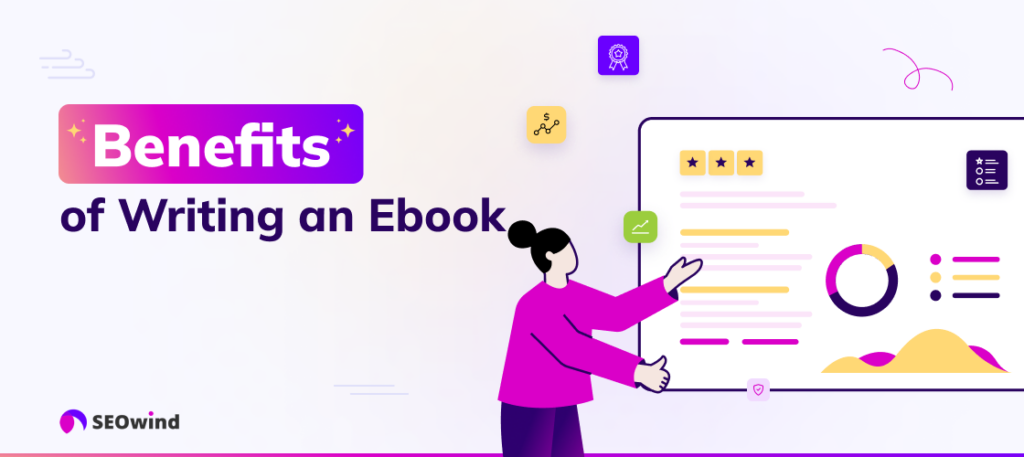
Ebooks have become increasingly popular to disseminate information and create new revenue streams for businesses and individuals. Understanding how to write an ebook provides you with numerous advantages:
Reach a Wider Audience
One significant benefit of writing an ebook is tapping into a global audience. With the prevalence of digital devices like smartphones, tablets, and e-readers, people can access content virtually anywhere. Offering your material in a digital format increases its accessibility and appeal to readers worldwide.
Establish Authority and Expertise
Writing an ebook lets you showcase your knowledge and expertise on a subject. This is essential to build credibility in your industry or gain recognition as a thought leader. Well-crafted ebooks help boost your authority by demonstrating that you have a comprehensive understanding of your field.
Generate Passive Income
An enticing aspect of producing an ebook lies in the potential for generating passive income. Once published, it can be sold multiple times without any additional effort. This makes ebooks an appealing business model for those seeking financial returns without having to manage their product constantly actively.
Cost-Effective Content Creation
Compared to traditional print publishing methods, creating an ebook is relatively inexpensive. There are no requirements for printing, shipping, or storage costs involved in electronic distribution. Moreover, various affordable tools are available to facilitate the editing, designing, and marketing processes associated with producing professional-quality ebooks.
Promote Personal or Professional Growth
The process of writing an ebook offers opportunities for personal and professional development. Through research and crafting content that resonates with readers, writers enhance their knowledge within their chosen topic area while improving their writing skills across different platforms.
What I learned from writing my own eBook?
I’ve published a couple of eBooks. The most recent one is Hack AI Writing with CyborgMethod™ [with eBook].

This is what works for me.
Think Your Structure Through
Before fingers hit the keyboard, pause for contemplation. A robust structure is the backbone that supports your ebook. Organize your thoughts by sketching an outline, like a roadmap through your book’s territory. This process might seem tedious now, but trust me, it will save you much time later.
Write Without Interruptions
Your creative river needs to flow unhindered at first. Let it be messy; write first and edit later. This method keeps you focused on nurturing ideas rather than being bogged down by self-critique. A couple of backspace button taps can wait until after your initial draft.
Collect Anecdotes and Real-life Examples in Advance
Stories breathe life into abstract concepts. They’re your secret sauce for cooking up gripping content! Gather anecdotes and real-life examples before leaping onto the writing stage; they’ll lend substance and authenticity to your work.
Rethink eBook Title – Hook Is Important
A catchy title is like an ornate keyhole enticing people towards unlocking the treasure that’s your ebook. Don’t limit it as an afterthought. Instead, let it evolve alongside the content creation process until both sync like harmonious melodies.
Make it Visually Appealing
Don’t forget, we live in the age of Instagram aesthetics! Your content might be fantastic, but a dreary presentation could make readers hit ‘exit’ faster than a lightning bolt. Experiment with fonts, color palettes, and imagery to spark curiosity and pull readers into your virtual labyrinth of knowledge.
How can AI help with writing an eBook?
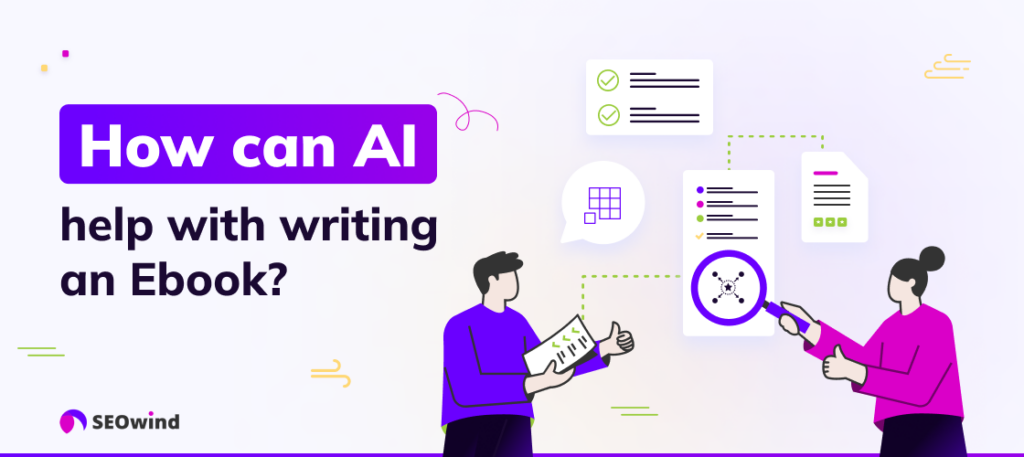
Leveraging artificial intelligence (AI) can be a game-changer when it comes to writing and publishing ebooks. AI presents numerous advantages in creating an eBook: from ideation to research, throughout the writing process, and even for marketing.
Let’s explore how AI tools can assist you in crafting an engaging ebook.
AI Streamlines Topic Selection and Research
One crucial aspect of writing an informative ebook is selecting a topic that resonates with your target audience. AI-powered analytics and data mining tools can help you identify trending topics in your niche while uncovering potential market gaps. Moreover, machine learning algorithms can analyze recent customer conversations on social media or forums to inform your decision-making process.
AI Enhances Content Creation
AI-based writing assistants have become increasingly popular among content creators due to their ability to:
- Generate relevant ideas and suggestions
- Write whole paragraphs or sections
- Provide real-time feedback on grammar, punctuation, sentence structure, and readability
- Aid keyword optimization for SEO purposes
- Speed up the overall writing process by offering recommendations based on semantic analysis
Although these tools are beneficial, they should be used as supplements rather than substitutes for human creativity and judgment.
AI Supports Outlining and Structuring Your Ebook
Planning out the structure of your ebook is vital for organizing information logically while maintaining reader engagement. Natural Language Processing (NLP) algorithms offer unique insights into text cohesion alongside generating coherent chapter outlines based on user inputs. Additionally, AI-assisted summarization tools enable you to condense large amounts of text into concise summaries suited for chapter introductions or overviews.
AI Personalizes User Experience
eReader applications powered by AI adapt various stylistic options – such as font size/typeface or color schemes – depending on users’ preferences or reading behaviors. This personalized approach fosters a better reader experience, which, in turn, increases the likelihood of success for your ebook.
AI Helps with Marketing Optimization
Effective promotion is vital in achieving visibility and conversions for your ebook. AI-powered marketing tools offer valuable assistance with the following:
- Precision ad targeting through data analytics
- Optimized content delivery based on user behavior and preferences
- Dynamic email campaigns utilizing machine learning to improve open rates and engagement
- Tracking performance metrics, which helps inform future marketing strategies
By harnessing AI’s potential throughout the ebook writing process, you can boost efficiency while significantly enhancing the appeal of your ebook for readers. From ebook idea to publication, AI is an invaluable ally in crafting ebooks that stand out in today’s competitive landscape.
How to Write Ebook – Step-by-Step Guide
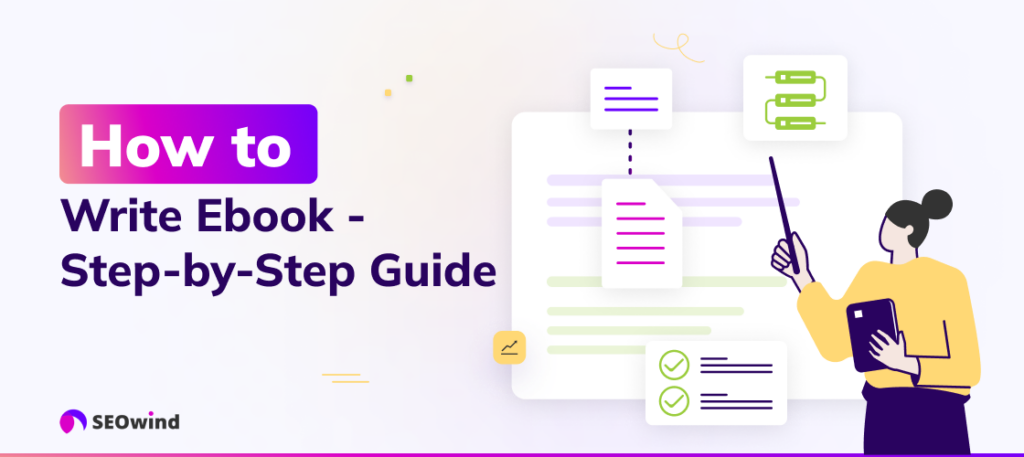
Step 1: Choose Ebook’s Topic
Before you start writing an ebook, choosing a subject that resonates with your target audience and aligns with your expertise is essential. This section covers researching your audience and picking a topic that appeals to them while utilizing artificial intelligence.
Researching Your Target Audience
A crucial step in selecting a suitable subject for your ebook is understanding the preferences and pain points of the intended readership. Here are some actionable steps:
- Examine competitor offerings: Identify gaps or perspectives you can explore within similar ebooks.
- Use online forums: Engage in discussions related to your industry to uncover common questions and concerns.
- Conduct surveys: Poll existing customers or followers about their interests and challenges.
- Analyze blog comments: Observe recurring topics or requests from engaged readers on relevant blogs.
- Monitor social media trends: Pay attention to hashtags, keywords, and influencers relevant to your industry.
Picking a Topic That Interests Your Audience
Once you have analyzed your target audience’s needs, you should be able to identify subjects that resonate with potential readers. When choosing a topic, consider the following guidelines:
- Combine your passion with reader interest: Select an area where your expertise and reader demand intersect.
- Ensure relevance across niche markets: Cater to multiple segments within broader market categories, such as beginners or procrastinators in personal development spheres.
- Address challenges readers face: Focus on themes that promise tangible solutions for struggles or objections voiced by involved individuals.
How can AI help?
Artificial intelligence tools simplify ebook creation and content planning by automating research processes and providing valuable insights into trending topics or areas lacking coverage.
Here’s how AI solutions could streamline the decision-making procedure when selecting an ebook theme:
- Algorithm-based trend analysis: Utilize AI-driven analytics software like Google Trends or BuzzSumo to track popular keywords related to the chosen field and understand search patterns.
- Market segmentation: Advanced machine learning algorithms can offer data-driven insights into unique topics worth covering within specific segments or niches in your industry.
- Social listening: Tap into AI-powered social monitoring tools like Talkwalker, Awario, or Mention to gauge the most discussed subjects on social channels and unearth valuable content ideas.
- Sentiment analysis: Employ AI-based sentiment analyzers to decipher public opinion regarding popular ebooks, giving you a better idea of what resonates with readers regarding style, length, tone, and substance.
By incorporating AI technology into your topic selection process, you unlock the potential to create an ebook that stands out due to its relevance and appeal while positioning yourself as an authoritative source within the subject matter.
Step 2: Define the Purpose of Your Own Ebook
Before embarking on the journey of writing an ebook, it’s crucial to define its purpose. This involves understanding why you’re writing the ebook and who your target audience is. A clear understanding of your goals will keep you focused throughout the writing process and help create an engaging, helpful book for your readers.
To determine the purpose of your ebook, consider these questions:
- Do I want to inform or entertain my readers?
- Am I aiming to solve a specific problem for my audience?
- Is this ebook part of a broader content marketing strategy?
- Do I want to showcase my expertise in a particular subject?
By answering these questions, you can establish the foundation of your ebook and ensure that it stays true to its purpose as you progress through the following steps.
Creating a Hook for Your Readers
An essential aspect of writing an ebook is capturing your audience’s attention. To achieve this, you must create a strong hook that piques readers’ curiosity and makes them want to read further. Here are some tips on crafting an intriguing hook:
- Ask compelling questions addressing a problem or challenge the reader might face.
- Share an interesting statistic or fact relevant to your topic.
- Begin with a captivating anecdote or personal experience showcasing your ebook content’s value.
- Use vivid imagery and descriptions to capture emotions and evoke curiosity.
- Present a bold statement or controversial viewpoint that sparks discussion.
How can AI Help?
Artificial intelligence (AI) tools have gained significant popularity in recent years due to their ability to streamline content creation, improve productivity, and generate creative ideas quickly. In the context of creating a hook for your ebook, these AI applications offer several benefits:
- Idea generation: AI-powered tools can help you brainstorm different hooks based on your theme or subject matter by offering various suggestions tailored to your target audience.
- Language optimization: Language-focused AI technologies such as natural language processing (NLP) algorithms can assist in refining your text, ensuring it is concise, engaging, and easily understood by readers.
- Audience targeting: Some advanced AI platforms feature audience analysis capabilities that aid in understanding what appeals most to your readers. They analyze previous user interactions with similar content and recommend appropriate hooks based on these insights.
- A/B testing: Many AI-enhanced writing platforms enable authors to conduct A/B tests to compare different versions of their hooks’ effectiveness before finalizing the one they prefer best.
Implementing AI technology when crafting a hook for your ebook streamlines the ideation process while increasing its chances of resonating with readers – ultimately making it more effective at engaging audiences.
Step 3: Brainstorm and Create Content Outline
Before diving into the actual writing process, it’s essential to spend some time brainstorming ideas and outlining your entire ebook. This step will provide a solid foundation for your content, ensuring it flows smoothly and logically for the reader. In this section, we’ll discuss how AI can assist in making the brainstorming and outlining process more efficient and how SEOwind can help in this crucial phase.
How can AI help?
Artificial intelligence has come a long way in recent years, offering valuable tools that writers can utilize during their work’s brainstorming and outlining stages. Here are several ways AI can help:
- Idea generation: Leveraging AI-powered tools like ChatGPT, you can generate topic ideas by entering relevant keywords related to your niche.
- Competitor analysis: You can analyze competitor content within your industry using AI-based applications such as SEOwind, MarketMuse, or Frase.io. These applications automatically collect in-depth data on topics others have covered, uncovering potential gaps in knowledge where your ebook could fit perfectly.
- Content structuring: Applications like SEOwind, Jasper or ChatGPT can assist you with creating outlines by suggesting headings based on input keywords or phrases—saving time and effort when structuring your content.
- Keyword research: Get assistance from AI-driven keyword suggestion and optimization tools like SEOwind, UberSuggest, or KWFinder to identify high-potential keywords strategically placed within your content.
How can SEOwind help?
SEOwind is an advanced suite of SEO tools designed to support writers throughout all phases of their projects – including brainstorming and outlining ebooks. Notably:
- Keyword research: SEOwind’s intuitive Keyword Research tool assists writers in finding suitable primary and secondary keywords for their content. It also recommends long-tail keyword variations to maximize organic traffic potential via search engines.
- Content Analysis: SEOwind analyzes top-performing content. This way, you can discover what interests your readers and their questions about specific topics.
- AI Content Outline: Based on content research, SEOwind is able to generate a comprehensive ebook outline covering the topic in-depth.
By incorporating AI technology and utilizing specialized tools like SEOwind during the brainstorming and outlining stage of writing an ebook, you’ll create a well-structured, concise resource filled with valuable information aimed at engaging and retaining readers throughout its entirety.
Step 4: Ebook Writing Process
Putting Words on the Page
After selecting a topic and outlining your ebook, it’s time to put words on the page. Keep in mind that writing an engaging ebook requires consistency and discipline. To maintain momentum throughout the writing process:
- Set daily or weekly word count goals.
- Establish a specific time dedicated to writing each day.
- Break down your outline into smaller sections to conquer one at a time.
- Ensure your ebook content remains conversational yet informative, utilizing the appropriate tone for your audience.
Remember that practice makes perfect. You’ll improve as a writer by consistently putting in the effort.
How can AI help?
Incorporating Artificial Intelligence (AI) tools into your writing process can significantly accelerate productivity and elevate the quality of your content. AI can assist with the following:
- Generating ideas using advanced language models like GPT-3.
- Summarizing existing resources for research purposes, saving valuable time.
- Checking grammar, syntax, punctuation, and readability—programs like ProWritingAid and Grammarly provide excellent support.
Overall, leveraging AI technologies enables you to focus on crafting creative content while ensuring accuracy and professionalism.
How can SEOwind help?
SEOwind is an invaluable tool for optimizing written material to achieve higher search engine rankings and increase organic traffic. When creating ebooks, consider using SEOwind to:
- Analyze relevant keywords from successful competitors’ content so you can seamlessly integrate them into yours.
- Create content for each subheading or even the whole ebook – as readers need to navigate effortlessly through chapters—or other structural elements.
- Generate metadata such as title tags or image alt-texts needed for online distribution platforms.
Achieving optimal SEO strategies will ultimately boost visibility and drive engagement with potential customers.
Breaking Down Each Chapter
As part of the writing process, analyze each chapter individually by focusing on specific aspects:
- Establish clear objectives for each chapter—ensure it aligns with your overall goal and adds value to readers.
- Evaluate organization—ensure chapters are logically ordered for seamless transitions between concepts.
- Double-check cohesiveness throughout the content by maintaining consistency in style and vocabulary.
By honing in on these critical components within individual chapters, you significantly enhance the overall quality of your ebook. Ultimately, this helps ensure reader satisfaction while promoting credibility as an authoritative source within your industry niche.
Tips for effective writing and storytelling techniques
In order to write an ebook compellingly, let’s break down some tools for setting the scene:
- The Power of Story Arc: This familiar trope helps maintain interest throughout the read by structuring your content around exposition (setting the scene), rising action (building tension), climax(the peak point of conflict/resolution), falling action (events resulting from resolution) before finally closing at denouement (the peaceful conclusion). The reader will be hooked as they anticipate one chapter smoothly transitioning into the next.
- Tension & Release: Readers love suspense; apply tension to hook them, then provide release through problem-solving or revelation.
- Vivid Description: Inject sensory details sparingly but effectively to evoke vivid imagery stimulating different senses in readers’ minds.
- Dialogue: Enable readers to grasp viewpoints directly via characters’ conversations. It personalizes them, allowing readers to connect more deeply with their stories.
- Theme Reinforcement: Is there a central idea you’d like your readers to take away? Make sure every event contributes towards painting this bigger picture.
Remember, these techniques are not set in stone but act as guides while shaping intriguing narratives that make people want to keep turning pages till dawn!
Addressing the reader’s pain points and providing solutions
Depict realistic situations that the reader can relate to and show them a way out. This builds credibility for you, making you their trusted advisor.
If you write an eBook on dog training, emulate scenarios wherein newbie pet owners struggle to house-train pups and provide actionable tips they could apply.
The ability to write an ebook that reflects mirrored experiences breeds familiarity, which pulls people towards purchasing eBooks coined as answers to their questions!
Creating engaging and informative content
How else does one lure curious eyeballs rapidly scanning through digital libraries? It boils down to creating compelling content! Both elements – information & engagement must be given equal importance. However, maintaining the delicate balance is what aids effective eBook writing.
- Novel and Insightful: Be original with the content presentation while ensuring there’s something new for readers to learn so they feel their time spent was worthwhile.
- Catering to Your Target Audience: If targeting tech enthusiasts or organic gardening amateurs_, adjusting language complexity for each group will signal relevance.
- Active Engagement: Sprinkle some interactive elements throughout your e-book – include activities like quizzes or puzzles related directly back to important concepts from previous chapters!
Crafting enticing eBooks entails valuing audience efforts, empathizing with struggles & evoking action. Hence, mastery over these keys certainly cements proficiency in ebook writing, eventually branding YOU as the author-to-refer!
Step 5: Polishing and Editing Your Ebook
After countless hours spent pouring your ideas, research, and knowledge into your eBook, it’s time to move on to the final stages before publishing – that is, polishing and editing. This phase will make sure that your contents are not only precise but also comprehensible while maintaining an engaging style in all parts of your book. Let’s go through these vital steps together.
Self-editing techniques to improve clarity and readability
One of the critical stages in producing a high-quality eBook is self-editing. Mastering this skill can save you time and money along the way.
- Remove unnecessary words. The secret to clean writing lies not in what you add but rather in what you eliminate from it. Be cautious about redundancy; repetition doesn’t necessarily mean clarity.
- Simplify your sentences. Keep them easily manageable for readers by applying Koppleman’s Law: Aim for short or medium-length sentences, under 25 words, where possible.
- Use direct language. Resort to an active voice more than a passive one to deliver a clear message quickly.
- Break up large chunks of text, and use bullets or numbered lists like we do here when necessary.
Proofreading for grammar, spelling, and punctuation errors
On top of unique content packed with value-added insights – correct grammar and spelling without a single error, Zinsser-style perfect punctuation captivates the attention of expert readers who have zero tolerance for such mistakes.
- Use AI tools such as Grammarly or ProWritingAid, which are quite handy tools for proofreading, but remember they shouldn’t replace manual revision completely.
- It helps reading aloud sometimes, as it makes some typos stand out.
- Pay close attention not only to misspellings but also to homophones like “there” versus “their,” easy-to-overlook details.
Evaluating the overall flow and coherence of the content
Now, let’s forget about the micro-level concerns like grammar or “Are my sentences too long?” and look at your eBook from a broader perspective.
Consider it as your reader would: Does each section naturally lead to the next? Can they quickly understand the concept based on your explanation?
For instance, are your transition phrases effective enough to link ideas together smoothly without leaving readers feeling disoriented with information gaps?
A well-organized flow adds significant value, enhancing readability and comprehension, making your ideas shine more than words can express. Indeed, it is an essential aspect of creating an enjoyable user experience besides stuffing lots of valuable data into one eBook.
Just remember – ‘A masterpiece is merely a loved work-in-progress.’ So keep revising until it reaches close to that ‘this works’ feeling in you. It sure takes effort, no doubt about that, but none of us were born literary geniuses overnight. The magic lies somewhere between perseverance & patience.
Self-Editing and Hiring a Professional Editor
Once you complete the initial draft of your ebook, self-editing is essential before passing it along to others for review. Refrain from relying solely on AI tools, as they can overlook subtleties in language or tone. Instead, be prepared to dedicate sufficient time and effort to refining your work.
Hiring a professional editor can be an excellent investment if you don’t feel confident editing. An experienced editor will:
- Identify inconsistencies or loose ends within the ebook content.
- Aid in ensuring optimal flow and readability.
- Assess stylistic elements such as tone and voice.
After receiving edits, carefully review all feedback before making revisions and producing the final version of your ebook.
Writing eBook with AI using CyborgMethod™
Using the power of artificial intelligence can significantly streamline your eBook writing process. The burgeoning field of AI offers a transformative technique known as the CyborgMethod™ that redefines the writing dynamics, particularly for those intrigued by the concept of co-writing with an AI.
Why Choose CyborgMethod™?
The premise behind embracing this method is its unique approach to striking a balance between human creativity and artificial intellect. It amalgamates man’s comprehensive understanding and feelings with the machine’s ability to churn out vast amounts of data efficiently, yielding a robust literature piece.
I’d describe it as having a diligent assistant who bridges the gap between one’s thoughts and their manifestation in words while maintaining perfect grammar, spelling accuracy, and coherence throughout. Indeed, shifting our conventional mindset towards drafting content can be worth exploring here.
Getting Started: Understanding Your AI Partner
Just like humans have inherent strengths and weaknesses, AI possesses specific capabilities and limitations, too. Expecting an intuitive exchange akin to human interaction can cause disappointment. Instead, consider outlining clear-cut instructions for your AI friend to provide apt responses.
Here’s where your skill comes into play – presenting well-defined prompts based on context can guide your digital partner toward generating meaningful content as per your requirements. Practice will render you more proficient at composing these triggers over time.
Efficient Drafting: Input & Edit Cycle
This brings us to one practical mechanic of crafting an eBook using the CyborgMethod™.
- Start by providing your AI tool with distinct instructions about what you wish to write about.
- Generate text using these prompts or commands.
- Examine the generated draft meticulously.
- Edit or tweak any portions that may need corrections or modifications.
Loop through steps 2-4 iteratively till a refined content meeting your satisfaction level evolves as output.
Above all else, remember not to get overwhelmed aiming for perfection at once. It’s a learning curve, after all.
While AI-enabled writing may initially appear as an impersonal, robotic process, the essence lies in customizing it to resonate with your voice. Weaving human elements into your narrative can help you deliver heartfelt dialogues while maintaining authenticity and relatability.
I believe honing this technique of co-authorship can be an exciting and rewarding expedition for aspiring eBook writers seeking an innovative approach. By combining our creative abilities with AI’s powerful algorithms under the CyborgMethod™ framework, we could very well script tomorrow’s bestsellers today!
Ebook Publishing Platform – Determining How to Distribute Your Ebook


Once you have written, edited, and designed your ebook, it’s time to decide on the best distribution method. There are several ways to distribute an ebook, all with their own set of advantages and disadvantages.
Self-publishing platforms
Self-publishing platforms allow you to publish and distribute your very own ebook directly to readers without needing a publisher. Some popular platforms include:
- Amazon Kindle Direct Publishing (KDP): As the most prominent ebook retailer globally, Amazon offers numerous advantages for self-published authors, such as access to a vast market reach, easy-to-use tools, and various advertising options.
- Barnes & Noble Press: A leading platform offering print-on-demand and eBook distribution.
- Apple Books/iTunes Connect: This is an alternative distribution option with worldwide reach through its platform for iOS devices.
Remember that each publishing platform comes with terms of service, royalties structure, formatting requirements, and exclusivity conditions when deciding which works best for you.
Selling through your website
Another way to distribute your ebook is by selling it directly from your website using e-commerce tools like Shopify or WooCommerce. This approach allows you to control pricing strategies and offer special discounts or promotions without having additional fees imposed by a third-party platform. It also aids in creating awareness about other products or services provided on your website.
However, it requires investment in marketing efforts since potential readers might only discover your book if they visit your site directly.
Subscription-based services
Subscription-based services like Scribd provide access to an extensive library of ebooks for users who pay monthly fees. Uploading your work on these services may give you exposure beyond traditional channels. However, remember that revenues depend on the number of reads generated within those systems.
Collaborating with content aggregators
Some authors collaborate with content aggregators like Smashwords and Draft2Digital—platforms that simultaneously distribute ebooks to several retail sites. While this route simplifies the distribution process, it usually involves a fee or revenue share for their services.
Choosing the right ebook format
Distributing your ebook requires ensuring compatibility with various platforms and devices. Common formats include:
- EPUB: A widely accepted universal standard that’s compatible with most e-readers.
- MOBI: Mainly used on Amazon Kindle devices.
- PDF: A popular choice for its ease of use, ensuring content appears precisely as designed regardless of the device.
Making your ebook available in multiple formats is highly recommended to optimize reach.
Determining which distribution method aligns with your objectives—whether maximizing visibility or revenue autonomy—is crucial when deciding how to disseminate your ebook successfully. Researching different options beforehand allows you to make informed decisions and effectively target prospective readers while accounting for purchasing and reading habits preferences.
Designing Your Ebook Cover and Visuals
An ebook’s design is critical to its success, directly influencing the reader’s perception and overall experience. Consider investing time and effort into designing your ebook to ensure an engaging, visually appealing publication. This includes formatting, choosing appropriate fonts and colors, incorporating visuals, and creating a captivating ebook cover. Let’s discuss some key points to keep in mind while designing your ebook.
Hiring a Designer to Complete Your Ebook
- Finding the Right Designer: The first step toward hiring a designer is researching to find professionals with relevant experience in designing ebooks or similar digital content. Platforms like Upwork or 99designs offer access to freelance designers specializing in various fields.
- Review Their Portfolio: Analyze their portfolio for the quality of work and expertise by checking out previously created designs that align with your expectations.
- Clearly Define Your Requirements: Before approaching designers, ensure you comprehensively understand what you want. Prepare a detailed brief encompassing your vision for the ebook design – from layout preferences to color schemes – and any other specific elements.
- Effective Communication: Maintain open communication channels with selected designers throughout the process; share feedback honestly without hesitation so they can deliver desired results effectively.
- Set Realistic Deadlines: Remember that exceptional designs require time; assign realistic deadlines when working with professionals considering revisions and incorporation of feedback too.
- Agree on Pricing Terms – Discuss pricing beforehand while respecting the designer’s skills, resources invested into production processes (such as procuring stock images), etc., ensuring transparent negotiations without hidden costs or surprises down the line.
- Inquire About Final Deliverables – It’s important to clarify which file formats will be provided upon completion (e.g., editable source files) and assurances about obtaining full ownership rights over completed designs.
By hiring a professional designer for your ebook, you gain access to their expertise in creating visually appealing and user-friendly layouts that will elevate your content, keeping readers engaged and leaving a lasting impression. Remember, investing in the presentation can prove highly beneficial for the overall success of your ebook.
Selecting Relevant Images
It’s essential to incorporate images that correspond with the context of your text. Relevant visuals help illustrate key points and reinforce important information. These can include photographs, illustrations, or icons:
- Utilize high-quality stock imagery: Many websites offer free or paid stock photos suitable for various topics.
- Create custom graphics: If you possess design skills or have access to a graphic designer, crafting unique illustrations representing your core ideas will set your ebook apart.
- Keep copyrights in mind: Always comply with copyright laws by using licensed images or obtaining permission to use copyrighted resources.
Integrating Charts and Graphs
For presenting complex information in an organized manner, consider incorporating charts and graphs using AI tools and software like Excel or Google Sheets. They help break down complex data into easily consumable visuals, which supports reader retention.
- Bar charts: Ideal for comparing data across categories
- Line charts: Suitable for displaying trends over time
- Pie charts: Effective when illustrating proportionate data distribution among different segments.
Aesthetics Matter
The visual elements should follow a consistent theme regarding color schemes and typography styles – maintaining harmony throughout the book. Consistency helps you establish your brand identity through your ebook presentation. Remember to strike a balance between texts and images without overwhelming one another – let them work together seamlessly.
Use AI for Image Generation
AI-based platforms such as DALL-E can assist you in generating relevant original visuals tailored to the concept you’re trying to convey within specific sections of your ebook – all by providing simple text-based descriptions of your desired image. These AI-generated images are unique and will enrich the overall presentation of your ebook.
By incorporating visuals into your content strategically, you will enhance the appeal and understandability of your ebook, encouraging readers to engage with and share your work. Ultimately, the integration of effective visual elements substantially impacts the success of any ebook.
Promoting and Marketing Your Ebook


After working to create your ebook, promoting and marketing it effectively is essential. Multiple strategies can help you reach a wider audience, generate buzz, and boost sales for your newly-published ebook. In this section, we will discuss email marketing, social media promotion, advertising strategies, webinars, and videos as methods to elevate your ebook’s reach successfully.
Email Marketing
Your email list is a powerful tool when promoting ebooks. Start by crafting engaging newsletters that inform subscribers about your new ebook release while sharing its benefits and key takeaways. Use captivating subject lines that pique their interest and entice them to open the email.
Keep the following points in mind:
- Leverage targeted email campaigns segmented by readers’ interests or preferences.
- Offer special discounts or promos for early purchases.
- Include compelling calls-to-action (CTAs) directing subscribers to purchase or download your ebook.
- Follow up with reminders or updates on any limited-time offers.
Social Media Promotion
Harness the power of social media platforms like Facebook, Instagram, Twitter, LinkedIn, or Pinterest to increase visibility for your ebook:
- Create customized visuals for each platform using relevant images and excerpts from your book.
- Utilize hashtags related to your ebook topic/genre and include appropriate keywords mentioned earlier—such as “how to write an ebook” or “how to create an ebook.”
- Collaborate with influencers within your niche who could share your content in exchange for cross-promotion.
- Interact with users interested in similar topics through comments or direct messages.
Advertising Strategies
Digital advertising plays a crucial role in getting more eyes on your product; consider running ads on platforms like Google AdWords or Facebook Ads Manager:
- Develop eye-catching ad creatives emphasizing what sets your ebook apart—using strong headlines and visuals.
- Select keywords that potential readers would use to search for your topic—draw inspiration from the clustered keywords provided.
- Optimize your targeting by focusing on demographics, geographic location, and interests based on your target market research.
Webinars and Videos
Video content is highly engaging and offers an excellent opportunity for you to discuss or showcase your ebook:
- Host webinars related to the subject of your ebook featuring interactive discussions or Q&A sessions with participants.
- Create informative videos that offer a sneak peek into your book’s contents—such as tutorials or “how-to” guides aligned with your text.
- Upload video content to platforms like YouTube, host Facebook Live events, or share live streaming sessions on Instagram.
Collaborating with Influencers or Industry Experts
Highly influential people within your genre can greatly assist in promoting your ebook effectively. Such partnerships usually come with an existing audience who trusts the influencer’s opinions—making them ideal candidates for promoting your work.
You might be wondering how to collaborate with these influencers or industry experts. Don’t worry; here are some steps to guide you through this process:
- Identify suitable individuals who are well-respected within your book’s niche. Their followers should consist of potential readers interested in topics covered by your ebook.
- Reach out to them articulately, outlining what they stand to gain from partnering with you. This could include mutual cross-promotion or providing their followers with exciting new content.
- Provide them access to a copy of your ebook so they can familiarize themselves with it before endorsing it.
- Engage them in discussions concerning possible promotion strategies that align both parties’ objectives while adding value for their audiences.
Remember that the core aim here isn’t merely selling. It’s about establishing lasting relationships beneficial for current and future projects as well. After all, collaborations are about building networks and trust between you, influencers, and their audience – thereby increasing chances of not just writing and selling an ebook successfully once but doing so consistently over time.
Now that we’ve gone through collaborating fundamentals, let me emphasize an important point – every person you reach out to won’t respond positively or even at all sometimes! It happens; don’t get disheartened – persistently explore other possibilities! There will always be successful ebooks that make money because their authors didn’t give up on finding the right partnerships.
In my experience of writing ebooks for money, I have learned that this process may take time, but it ultimately pays off by expanding your reach and increasing your ebook sales. Now, get out there, or better yet – stay in with a good cup of coffee and start connecting!
Common Mistakes When Writing an Ebook
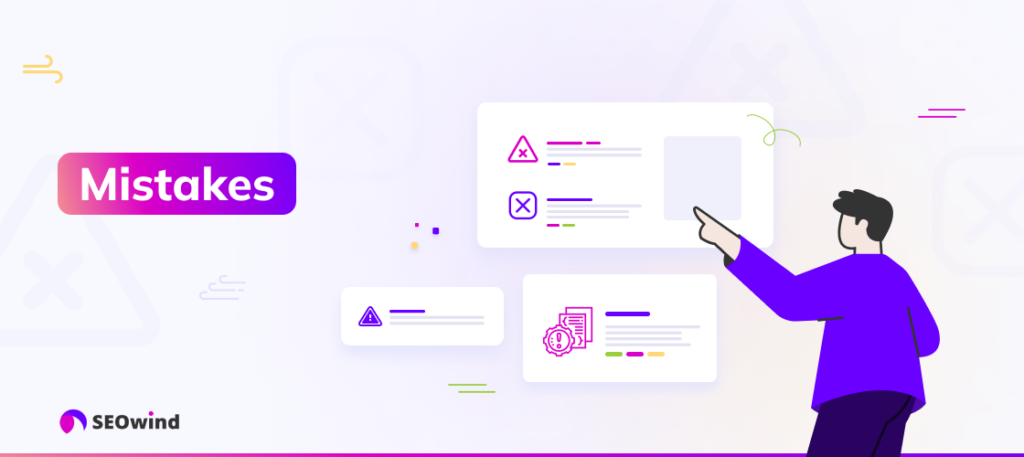

Writing an ebook can be a rewarding experience. Still, it’s crucial to avoid some common mistakes that might sabotage your success. To help you sidestep these pitfalls, let’s explore a few missteps authors often make when learning to write an ebook.
Inadequate Planning and Research
A well-researched outline is essential for writing a coherent and engaging ebook. Authors who neglect this step risk creating disjointed content with confusing or meandering arguments. Invest time in thorough planning and research to give your book the needed structure.
- Do comprehensive background research on your topic
- Create a detailed outline of chapters and sub-sections
- Allocate time for revisions before publishing
Focusing Too Much on Word Count
When figuring out how to create an ebook, one might erroneously assume that more pages equal better quality. However, too much word count can lead to poorly-written material filled with fluff or repetition. Instead, aim for clear and concise content.
- Use relevant examples without over-explaining
- Keep sentences short and direct
- Prioritize quality over quantity
Neglecting Your Target Audience
Understanding your readers’ preferences and expectations is vital when crafting your ebook. Skipping audience analysis could leave you writing content that doesn’t resonate with potential readers.
- Know the demographics of your target audience
- Tailor your tone and style accordingly
- Address reader-specific pain points with solutions
Insufficient Editing and Proofreading
Neglecting the editing process is another common mistake while writing ebooks. A polished final product demands thorough proofreading, editing, and formatting.
- Consider enlisting the help of beta readers or professional editors
- Ensure consistency in style, voice, fonts, and headings throughout the text
- Double-check grammar usage before publishing
Ignoring Promotion and Marketing Strategies
One frequent oversight among new authors is underestimating the importance of marketing strategies for their ebooks. Effective promotion tactics are vital to reaching a broader readership.
- Develop a robust marketing plan tailored to your target audience
- Leverage email campaigns, social media, and collaborations with influencers
- Create a compelling landing page or website dedicated to your ebook
By identifying and addressing these common errors before they occur, you’re better equipped to write an ebook that captivates your audience and achieves its intended goals.
Ebook File Formats
When learning to write an ebook, one crucial aspect is understanding the available file formats. Different ebook readers and platforms support various file formats, so choosing one or more formats suitable for your target audience is essential.
This section explores some popular ebook file formats you should consider.
EPUB (Electronic Publication)
EPUB is a widely accepted and versatile format supported by numerous online marketplaces and devices such as Amazon Kindle, Apple iBooks, Barnes & Noble Nook, Kobo eReader, and Google Play Books. It consists of reflowable text content that adapts to the screen size of different devices, enhancing the reader’s experience.
MOBI
MOBI is another popular file format used for ebooks on Amazon Kindle devices. While the format allows for advanced formatting capabilities, its compatibility is limited compared to EPUB since it’s used mainly with Amazon products.
PDF (Portable Document Format)
PDFs are also frequently employed as ebook files because they preserve formatting across various devices. However, they are less flexible than other ebook file formats since they have fixed layouts which may restrict user adaptability on smaller screens or mobile devices.
AZW/AZW3
Amazon developed these specific ebook file formats for their Kindle e-reader devices. They offer similar features to MOBI but can include added benefits like additional font support and improved compression levels.
When deciding which file format(s) will be best suited for your ebook-publishing goals, consider not only readability but also platform-specific restrictions and distribution requirements. The most popular platforms are Amazon Kindle Direct Publishing (KDP), Apple iBooks Author (iBA), Barnes & Noble Press, Kobo Writing Life (KWL), and others.
Remember that you might need to prepare multiple ebook versions in different formats for optimal reach across various platforms. Suppose you’re unsure which format to choose. In that case, software tools such as Calibre can assist you in converting between different ebook file formats.
Types of Ebooks
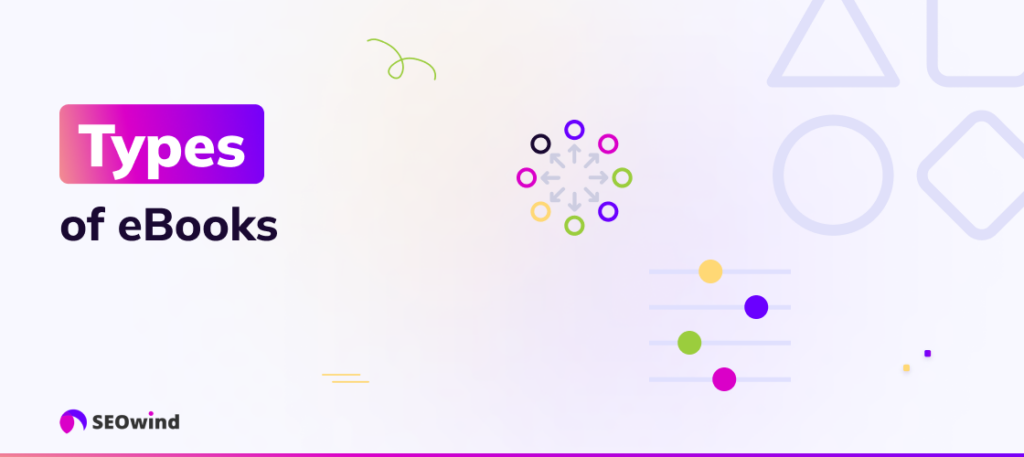

Ebooks come in various forms, each catering to different audiences, genres, and purposes. Understanding these types can help you decide the best approach for writing an ebook that resonates with your target readership. Here are some popular ebook formats incorporating 3-5 relevant keywords:
- Informational guides: These ebooks provide instructional or educational content on a specific subject matter. Examples include how-to ebooks, tutorials, and manuals covering digital marketing strategies and gardening tips.
- Narrative non-fiction: An ebook that tells real-life stories while maintaining a solid narrative structure. This format suits biographies, memoirs, travel writing, or historical accounts.
- Fiction: From mystery novels to romance to science fiction and fantasy titles—the scope for creativity is endless when writing a fictional ebook. Crafting compelling characters and engaging plotlines will captivate your audience.
- Short story collections: An assemblage of short narratives under one cover targeting a common theme or genre such as suspense, satire, or contemporary issues. It’s ideal for writers who prefer working on bite-sized stories rather than full-length novels.
- Poetry and Essays: Ebooks dedicated to poetry collections or thought-provoking essay compilations cater to niche readers seeking contemplation and reflection through literary works.
- Children’s books: Filled with vivid illustrations and captivating narratives, children’s ebooks cater to young readers just starting their reading journey.
- Interactive ebooks: Enhanced with multimedia elements like audio clips, videos, or interactive quizzes, these ebooks aim to create an immersive reader experience by combining textual content with dynamic visual features.
- Workbooks and templates: Supplementing a primary instructional guide (such as an informational guide), these resources are designed for the practical application of skills—providing hands-on activities or pre-designed templates that aid readers in implementing what they have learned.
By considering the various types of ebooks available, you can establish how to create an ebook that best suits your intended audience and effectively portrays the content you wish to share. Regardless of your chosen format, remember the importance of a cohesive structure, engaging narrative style, and well-researched information when writing your ebook.
Creating a Dedicated Landing Page for Your Ebook


Creating an engaging and effective landing page is a crucial step in successfully marketing your ebook. This is the online space where potential readers are introduced to your work, learn more about it, and decide whether they want to download or purchase it. In this section, we’ll explore how to create a dedicated landing page that optimizes conversions.
Key Components of an Effective Landing Page
To begin, let’s discuss the essential components of an ebook landing page:
- Attractive Headline: Capture visitors’ attention with a catchy, engaging, and informative headline that communicates the main benefit of reading your book.
- Subheading: A concise subheading can provide additional details and entice readers to act.
- Compelling Description: Clearly explain what your ebook offers, who its target audience is, and why it’s valuable.
- Visuals: High-quality visuals like images and illustrations can help break up text and make the page more visually appealing.
- Call to Action: Use clear language to encourage visitors to download or buy your ebook immediately.
- Social Proof: Showcase testimonials from satisfied readers or endorsements from industry experts.
How AI Can Help Create a Dedicated Landing Page
Artificial intelligence (AI) tools now make it easier than ever before when it comes to craft high-converting landing pages, even if you’re not an experienced web designer.
- AI-driven copywriting tools can help you generate attention-grabbing headlines, engaging descriptions, and compelling calls to action based on best practices.
- Design-focused AI software can assist with selecting eye-catching visuals for your page or even create custom illustrations relevant to your topic.
- Conversion rate optimization AI tools analyze user behavior data points while refining various elements on the landing page for better results.
Tips for Successful Ebook Landing Pages
Keep these tips in mind as you build out your landing page:
- Make sure your page is mobile-friendly, as many visitors will access it on their smartphones or tablets.
- Keep the design clean and simple to minimize distractions and focus attention on your ebook.
- Emphasize readability using clear fonts, proper spacing, and contrasting text colors.
- Consider offering a free ebook preview so that potential readers can taste what they’ll get before committing to a purchase.
By following these steps and leveraging AI tools where possible, you’ll be well ahead when creating an effective landing page for promoting your ebook. This approach helps generate more downloads or sales and solidifies your reputation in the eyes of potential readers.
Highlighting Quotes and Statistics
When learning how to write an ebook, it’s essential to incorporate quotes and statistics that provide credibility for your content. By highlighting relevant data and expert insights, you can strengthen your arguments, engage readers, and make your ebook stand out in a saturated market.
Citing Reliable Sources
To emphasize the significance of various aspects of your work, rely on reliable sources such as academic journals or reputable industry reports when quoting studies or citing statistics. Avoid using outdated or unsubstantiated information that may weaken your credibility. Make sure to cite these sources accurately within your content.
Embedding Quotes Effectively
When incorporating quotes into your ebook, aim for smooth integration within the context of your writing. Introduce each quote briefly, explaining who is being quoted and why their opinion matters while offering background information about them or their work. This approach provides proper context and enhances overall readability.
- Blockquotes: For longer quotes (typically more than 40 words), use blockquote formatting to visually separate the text from the main body of the copy. Be mindful not to overuse blockquotes. They should be used sparingly for exceptionally compelling statements.
- In-line quotes: For shorter quotes, embed directly within the text flow using quotation marks to indicate verbatim content.
- Pull quotes: If a powerful statement encapsulates one of your central themes or points effectively, consider utilizing pull quotes — standalone snippets extracted from the text with larger font sizes and typically placed at strategic positions throughout chapters.
Presenting Data Visually
Visualizing key facts or findings through charts, graphs, infographics, and tables will enhance comprehension and boost reader engagement since many people respond well to visual cues. Be sure graphics are consistent with brand guidelines and epub file format requirements (if applicable).
You will successfully engage and educate your readers by strategically placing thought-provoking quotes and compelling statistics throughout your ebook. This approach contributes to the overall value of your content and encourages a broader reach within your target audience.
Placing Calls to Action Within Your Ebook
A crucial aspect of writing an effective ebook is incorporating impactful calls to action (CTAs) within your content. CTAs motivate and encourage readers to sign up for a newsletter, make a purchase, or engage with you on social media platforms. To guide you through placing captivating CTAs in your ebook, let’s discuss proper CTA placement, CTA variety, and tips for writing compelling CTAs.
Proper CTA Placement
Placing CTAs strategically within your ebook is essential for maximized impact. Readers should not be overwhelmed with numerous calls to action covering each page, nor should they struggle to find them when needed. Here are some recommendations for suitable locations:
- The end of any value-added section: After providing valuable information or insights from your topic, incorporate a CTA that correlates with the presented content.
- In-between chapters: Create a seamless transition by adding a relevant CTA after one chapter before starting another.
- Conclusion: Summarize important points from your ebook and include your primary CTA in this section.
Variety in Calls to Action
Diversifying your CTAs adds dynamism while targeting different reader preferences. Some examples of varied CTAs include:
- Asking readers to sign up for newsletters containing similar content
- Inviting readers to attend webinars or events related to the subject
- Promoting other ebooks or products in line with the ebook’s theme
- Encouraging engagement on social media channels like Twitter or Facebook
- Offering discounts or time-sensitive promotions if applicable
Tips for Writing Compelling CTAs
To craft powerful and enticing calls to action that effectively persuade readers, consider these guidelines:
- Be clear and concise: Readers should quickly understand what action they need to take.
- Employ strong verbs: Use persuasive language and action words such as “subscribe,” “learn more,” or “join now” to boost reader engagement.
- Evoke a sense of urgency: Encourage immediate action by incorporating phrases like “limited time offer” or “act now.”
- Utilize persuasive design elements: Ensure your CTAs visually stand out within your ebook by using colors, fonts, and placement that attract attention.
In conclusion, integrating compelling CTAs throughout your ebook is indispensable for achieving maximum impact. Thoughtful placement, diversity in types of CTAs, and effective writing techniques all work together to create powerful calls to action that drive reader engagement and entice them to take the desired steps.
Converting to PDF Format
When presenting your E-book professionally, one popular format is the Portable Document Format (PDF). This file type retains formatting and design elements from various software applications and maintains consistency across different devices or platforms. Converting your Ebook to PDF ensures a smooth reading experience for your audience. In this section, I’ll share a step-by-step guide on converting your finalized content into a PDF document.
- Choose a suitable software: Several programs allow you to export documents into PDF format. Some standard options include Microsoft Word, Google Docs, Adobe Acrobat Pro DC, and free online tools like Smallpdf or Soda PDF.
- Format your Ebook: Before converting the file, review the layout of your content thoroughly. Check fonts, images, headers, footers, page numbers, margins, and additional visual elements. Formatting varies depending on the chosen software but always ensures alignment with standard ebook norms.
- Export as PDF: Once you have formatted your Ebook correctly:
- In Microsoft Word: Go to “File”> “Export”> “Create PDF/XPS Document”
- In Google Docs: Choose “File”> “Download”> “PDF Document (.pdf)”
- In Adobe Acrobat Pro DC, Click “Tools,” then select “Create PDF.”
- Optimize file size: High-resolution images may lead to large file sizes; therefore, consider optimizing them using built-in compression options or third-party software like Adobe Acrobat Pro DC.
- Quality check and access settings: After conversion, recheck for layout issues or errors that might have occurred during the process. Additionally, apply desired security settings such as password protection or permissions restricting printing/copying/editing by recipients.
- Test compatibility: To avoid readability issues with various electronic devices and platforms (e.g., desktops vs smartphones, Windows vs Mac), thoroughly test your converted PDF for compatibility.
Converting your Ebook to PDF format provides a professional, easy-to-read appearance. It guarantees the preservation of formatting across different platforms. Choosing appropriate software and following best practices for layout, optimization, security settings, and compatibility testing is vital to enhance your readers’ experience. Remember to utilize keywords such as how to create an ebook or write an ebook when promoting your newly converted PDF masterpiece!
Tracking the Success of Your Ebook
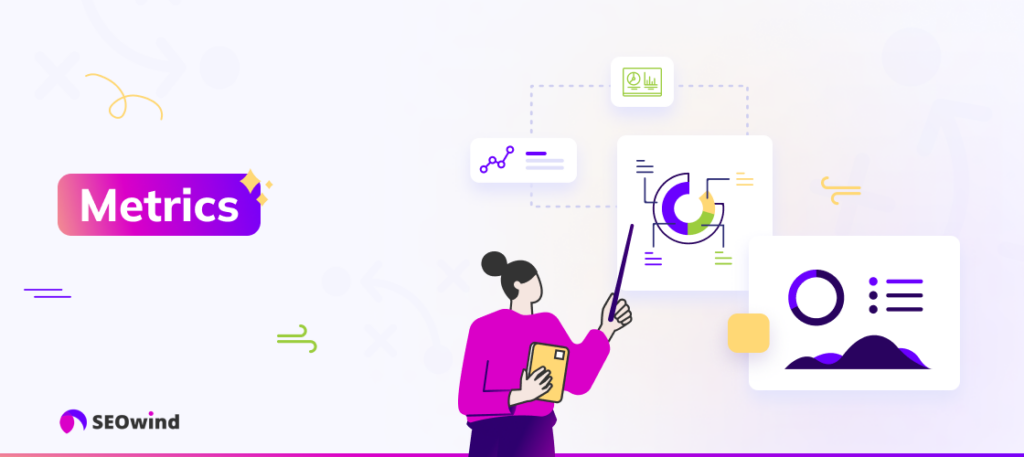

To understand how well your ebook is performing and optimize your marketing strategy, tracking its success is crucial. This involves monitoring various performance metrics and data points that shed light on the effectiveness of your promotional efforts and the book’s overall appeal to readers. In this section, we’ll cover different ways you can measure your ebook’s success using insightful analytics.
Analyzing Sales Data
Analyzing sales data is one straightforward way to gauge your ebook’s performance. Depending on the platform where you’re selling or distributing your ebooks – such as Amazon Kindle Direct Publishing (KDP), Barnes & Noble Press, or Apple iBooks Author – access detailed sales reports to:
- Evaluate daily, weekly, and monthly sales figures.
- Compare sale trends across different periods.
- Identify peak times for improved future promotions.
Monitoring Social Media Engagement
Keep an eye on how people interact with your social media posts related to the ebook. Track essential engagement metrics like likes, comments, shares, retweets, and clicks. Utilize these insights to:
- Understand popular content within the target audience.
- Check which social media platforms yield better results.
- Optimize self-promotion efforts accordingly.
Evaluating Email Marketing Performance
If you’re promoting your ebook through email marketing campaigns or newsletters sent to subscribers’ lists, assess their effectiveness through open rates, click-through rates (CTR), and conversion rates. These statistics enable you to:
- Improve email subject lines for higher open rates.
- Enhance email content for increased CTRs.
- Comprehend subscriber behavior patterns for better-targeted campaigns.
Google Analytics and UTM Parameters
Implementing Google Analytics on your website or landing page helps monitor traffic sources and user behavior when they visit pages dedicated to the ebook promotion. To get even more granular data about specific marketing activities (such as social media posts, email campaigns, or paid advertising), use UTM (Urchin Tracking Module) parameters in your links. This detailed information will allow you to:
- Understand which marketing channels drive better results.
- Identify the most engaging content for your audience.
- Optimize all marketing efforts for maximum impact.
Gathering Customer Reviews and Testimonials
Customer reviews and testimonials serve as valuable feedback to improve your ebook’s content and influence potential readers’ purchasing decisions significantly. Monitoring ratings on online platforms like Amazon KDP and Goodreads helps clearly understand how well the ebook resonates with its target audience.
Are Ebooks Profitable?


The rise of digital platforms, self-publishing, and online marketplaces have made publishing ebooks more popular and accessible for aspiring writers. Many authors and entrepreneurs want to know whether ebooks can become a profitable venture or a supplemental income source. Let’s explore some factors that contribute to the potential earning power of ebooks.
Passive Income Potential
One significant advantage of writing an ebook is the creation of a passive income stream. Once your ebook is written, published, and marketed effectively, it generates revenue without requiring your constant intervention – as long as it continues to sell, you’ll earn money even while you sleep.
Low Cost of Production
Creating an ebook requires a lower initial investment than traditional printed books or physical products. As an author writing your book on how to create an ebook, for example, you don’t need to worry about printing costs or storage fees. This significantly lowers financial barriers and enhances the chances of generating profit from your work.
Reach a Wider Audience
Digital books provide access to a global readership made possible by various largest ebook distributors like Amazon Kindle Direct Publishing (KDP), Apple Books, Nook Press, etc. With online distribution channels facilitating greater visibility for your book to create an ebook in 7 steps or another relevant topic under how to write an ebook niche, authors can tap into larger markets than would be typically available through conventional brick-and-mortar stores.
Pricing Strategy
Your choice of pricing strategy plays a vital role in determining the profitability of your ebook. An effective approach involves researching similar books within your chosen niche and finding the ideal balance between affordability and perceived value.
However, consider these essential points when evaluating whether ebooks can indeed be profitable investments:
- Competition: The relatively low barrier to entry has led many aspiring authors to produce eBooks reflecting both diverse topics, such as “How long does it take to write an eBook?” or How to create an eBook. Consequently, there has been increased competition among eBooks, potentially impacting your profitability.
- Marketing: To be successful in the ebook market and maximize profitability, efficiently marketing your product is critical. Email marketing, social media promotion, and advertising are a few effective strategies when crafting promotional campaigns for your ebook.
- Quality: Your ebook’s quality significantly impacts your chances of gaining positive reviews and recommendations from word-of-mouth marketing. These help boost sales revenue by appealing to new readers who value well-written, insightful content covering topics.
Ebooks can prove profitable for authors possessing tremendous patience, perseverance, and dedication toward producing high-quality content while deploying powerful marketing tactics. It is crucial to remember that success may take time to materialize. Consistent effort over time governs the true profit potential of your eBook endeavor.
Best Way to Start Writing Your First eBook
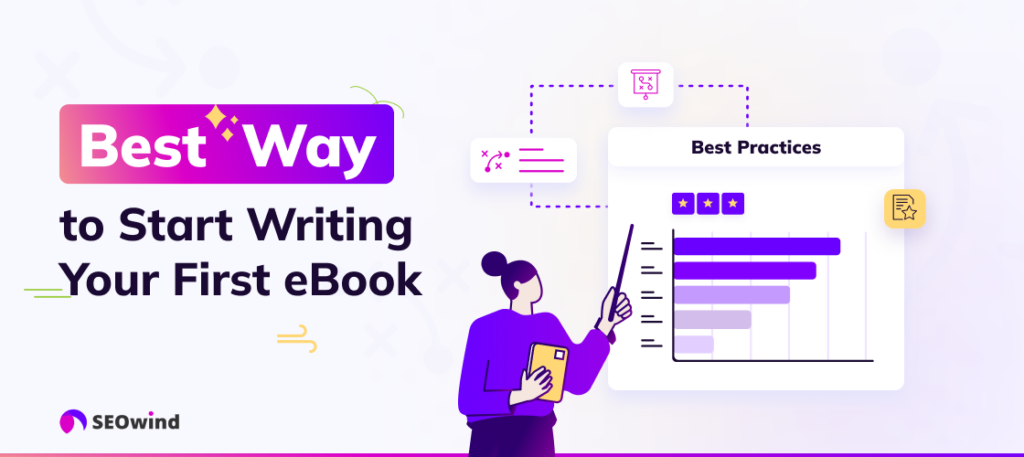

Are you wondering ‘how to start an ebook’? Let me commiserate with you. I remember how daunting it felt when I was just about starting my first eBook. The whole notion of spinning off countless pages seemed overwhelming. But truth be told, the beginning is usually the most challenging part, and things gradually fall into place.
Settle on a Compelling Idea
Your journey toward writing your first eBook begins by identifying a compelling idea that will grab attention. Are there concepts or issues you’re passionate about? Is it something others are waiting anxiously to delve into? Simply put, write about what people care about.
Sketch Out an Outline
Next, organize your thoughts by sketching out an outline for your eBook. Create chapters and begin jotting down ideas under each chapter heading. These will guide your writing process and keep you focused.
Develop a Regular Writing Schedule
Consistency is vital in this journey. Choose the times of day when you feel most productive, and commit these periods strictly to writing. Below are more insights on how best to kickstart your first eBook:
Kick-off With a Strong Introduction
Your introduction is crucial as it sets the tone for the rest of the book. Make sure it captures readers’ interest from the get-go. Promise them value and ensure you deliver as they traverse through subsequent pages.
Get Down To Actual Writing
Here’s where the rubber meets the road: getting down to actual writing. Here’s one strategy that worked wonders for me – focus solely on putting pen to paper (or fingers to keyboard) during scheduled writing sessions; editing comes later.
Lastly, understand that every writer experiences different scenarios while working on their projects. Don’t compare yourself with others. Stick with techniques and tips that work best for you. Enjoy the thrill that comes with seeing your ideas morph into a book. Give it your best shot, and remember – every pro was once an amateur.


